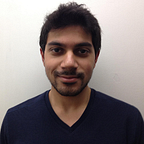I Tried the HTC Vive…and So Should You
The HTC Vive (powered by SteamVR) came out a few weeks ago, and I had the chance to try it out at the Microsoft flagship store on 5th Ave in New York. Here are some of my (mostly) unfiltered thoughts:
- I tried three modules: the first was an incredibly immersive exploration of a sunken ship deck. I immediately noticed how fluidly the scene changed, i.e. how good the head tracking system was. That is, when I turned my head in any direction, the Vive maintained a very high frame rate, showing no lag or latency as it refreshed a complex, moving scene. A massive whale swam by. It was glorious.
- It was slightly disorienting looking at my hands and seeing nothing there, or looking down and seeing the absence of a body between my head and the ship deck. For this first module, I was unable to interact with the environment, I was simply an observer. A brain in a vat of virtual space.
- Another amazing phenomenon I noticed was the Vive’s ability to recognize spatial boundaries, also known as positional tracking. Whenever I wandered too close to the edge of the demo arena, an outline of a wall would appear, indicating the presence of an obstacle. I was worried this would disrupt the experience, but it helped me create a great spatial map in my head of the boundaries for exploration. Humans are remarkably good at spatial memory, and it was easy to remember where the physical and virtual objects were located relative to me, even when I wasn’t looking at them.
- The value of sound is immense. I’ll go into more detail in another post, but our auditory system 1) actually has a higher reaction time and temporal resolution than our visual system, 2) has a 360/spherical field, and 3) is selective (the cocktail party effect). Listening to binaural auditory cues in the virtual world (e.g. hearing whale sounds underwater) was incredibly effective at creating a sense of motion and distance from objects, and at drawing attention to things outside my periphery.
- The second module I tried was far and away the best one: Tilt Brush. The demo moderator placed a controller in each hand, and the app began in a dark, empty room. In real life, the controllers looked like Wiimote nunchucks. In virtual life, I held a cuboid palette in my left and a paintbrush cursor in my right. Tilt Brush allows users to paint in 3 dimensions, with an incredible array of brushes, effects, and artistic media available. It is a phenomenal application, and an experience that singularly conveys the vast potential of virtual reality. The best of virtual space may be in its use as a blank canvas upon which nearly anything can be imagined and expressed. Hence a thought that some have begun to express, including Kevin Kelly in his Wired article on Magic Leap: the magic of mixed reality is in its tools for creation. (I’ll talk more about this in an upcoming post)
- It would be interesting to see what different people, especially children, start creating as their first Tilt Brush project. Me, I started doodling. I drew a simple cartoon character, more life size than ever. As I was painting/sculpting/we-need-a-new-word-for-this-amazing-thing, the moderator suggested I try walking through my drawing. This was a real aha moment, because that was something I had never thought of, a dimension that had never been accessible to me. Walking through the doodle felt surreal, like nothing was there, although I knew for certain my drawing was real — it was somehow trapped between virtuality and reality.
- The final app demo I tried was a first-person shooter with attack droids that flew up in waves. This was fun and immersive, and surprisingly challenging. Something that would be interesting — adding variable weights to the controllers based on the app in question. The game would have been much more realistic if I could feel the weight of the guns and the shield. Or perhaps haptics gloves could be used to add the dimensionality of weight?
Overall, an incredibly immersive experience. The Vive is arguably the most quality VR experience out there to date, due to its excellent tracking system. Great head tracking is a given — allowing users to turn and rotate their heads in all directions. However, what sets the Vive apart is its unique positional tracking system, which smoothly tracks the body in 3D space. This is what allows the wearer to walk around. It lets us explore the world more naturally, get closer to virtual objects and control where we are in the virtual space. Even the Oculus Rift remains a primarily ‘stand/sit still’ device, as it’s positional tracking is fairly restricted. Positional tracking is absolutely huge, because it lets the user take more control over the virtual environment, becoming a more powerful actor in the scene. I could have sat down and watched the whale swim by. I could have turned my head and seen the rest of the ship and it would have still been awesome. But being able to walk right up to the whale’s eye as it passed — that was sublime.
Unfortunately, when I put my hand out to interact with the whale, nothing appeared. Perhaps accurate bodily representation is the next level in creating a more immersive virtual reality experience. In fact, just this week Dutch company Manus VR announced that they are developing arm tracking for the Vive, getting rid of the ‘disembodied hands’ look that you can see in some VR applications today.
People say you can’t explain VR, you have to try it for yourself. There are demos of the Vive and Rift all over the country —highly recommend taking a quick trip to a local store or VR event and trying it out for yourself.
